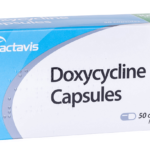How Long Do Doxycycline Side Effects Last?

Side effects are one of the major things a patient looks out for in a medication. The National Cancer Institute (NCI) defines an adverse effect as “an unexpected medical problem that happens during treatment with a drug or other therapy.” Unwanted effects can result from a physician’s advice and from medications or treatments, including complementary and alternative therapies. They can lead to complications.
Reports from clinical trials describe adverse events (AEs) and serious adverse events (SAEs). SAEs include death, birth defects, complications that require hospitalization, or permanent damage.
Many Patients are frightened by potential side effects. They may have also experienced previous side effects with the same or similar medicine. Additionally, patients report not taking their medication because they may have witnessed side effects experienced by a friend or family member who was taking the same or similar medication. Seeing those side effects experienced by someone else may have led them to believe the medication caused those problems.
What is doxycycline?
Doxycycline is a broad-spectrum bacteriostatic agent synthetically derived from naturally occurring tetracyclines produced by Streptomyces sp. bacteria. Doxycycline was invented and clinically developed in the early 1960s by Pfizer Inc., New York, NY, and marketed under the brand name Vibramycin. Vibramycin received FDA approval in 1967, becoming Pfizer’s first once-a-day broad-spectrum antibiotic. The additional indication for malaria prophylaxis was obtained in 1994 with a supplemental New Drug Application. Doxycycline is on the World Health Organization’s List of Essential Medicines and is available as a generic medicine. In 2019, it was the 90th most commonly prescribed medication in the United States, with more than 8 million prescriptions.
Doxycycline is used to treat or prevent a variety of infections caused by bacteria, including:
• Pneumonia or other respiratory tract infections
• Infections of the skin or eye
• Infections of the lymphatic, intestinal, genital, or urinary systems
• Infections spread by ticks, lice, mites, and infected animals
• Infections spread by contaminated food and water
• Anthrax
• Plague or tularemia
• Malaria and MRSA
This medicine is also used to treat acne and rosacea (a skin condition that causes redness, flushing, and bumps on the face).
How should doxycycline be taken?
Doxycycline comes as a capsule, delayed-release capsule, tablet, delayed-release tablet, and suspension (liquid) to take by mouth. Doxycycline is usually taken once or twice a day. Drink a full glass of water with each dose. If your stomach becomes upset when you take doxycycline, you may take it with food or milk. However, taking doxycycline with milk or food may decrease the amount of medication absorbed from your stomach. Talk with your doctor or pharmacist about the best way to take doxycycline. Follow the directions on your prescription label carefully, and ask your doctor or pharmacist to explain any part you do not understand. Take doxycycline exactly as directed. Do not take more or less of it or take it more often than prescribed by your doctor.
Swallow the delayed-release tablets and the Acticlate CAP capsules whole; do not split, chew, or crush them.
If you cannot swallow certain delayed-release tablets (Doryx; generics) whole, carefully break up the tablet and sprinkle the contents of the tablet on a spoonful of cold or room temperature (not hot) applesauce. Be careful not to crush or damage any of the pellets while you are breaking up the tablet. Eat the mixture right away and swallow without chewing. If the mixture cannot be eaten right away it should be discarded.
Shake the suspension well before each use to mix the medication evenly.
If you are taking doxycycline for the prevention of malaria, start taking it 1 or 2 days before traveling to an area where there is malaria. Continue taking doxycycline each day you are in the area, and for 4 weeks after leaving the area. You should not take doxycycline for the prevention of malaria for more than 4 months. Continue to take doxycycline even if you feel well. Take all the medication until you are finished unless your doctor tells you otherwise.
One doxycycline product may not be able to be substituted for another. Be sure that you receive only the type of doxycycline that was prescribed by your doctor. Ask your pharmacist if you have any questions about the type of doxycycline you were given.
How quickly does doxycycline work?
Doxycycline is almost completely absorbed after oral administration. Peak concentrations are reached within two to three hours after dosing; however, it may take up to 48 hours before infection-related symptoms start to abate. How quickly you get better after doxycycline treatment is dependent on the severity of your condition. If you are using doxycycline for acne, you might start seeing improvement within 2 weeks, but it can take up to 12 weeks (or 3 months) to see the full benefit of the treatment. You’ll know doxycycline is working for you when you see less acne forming and your skin starts to look clearer. Even though you might feel better after a few days of treatment, it’s best to finish the entire antibiotic regimen in order to fully resolve your infection. This can also help prevent antibiotic resistance. Don’t stop your doxycycline regimen early unless your healthcare professional says you can do so.

Doxycycline side effects
Doxycycline can cause side effects. Some are more common, and some are serious.
More common side effects
The more common side effects of doxycycline can include:
• loss of appetite
• nausea and vomiting
• diarrhea
• rash
• sensitivity to the sun
• hives
• temporary discoloring of adult teeth (goes away with dentist cleaning after the drug is stopped)
If these effects are mild, they may go away within a few days or a couple of weeks. If they’re more severe or don’t go away, talk to your doctor or pharmacist.
Serious side effects
Call your doctor right away if you have serious side effects. Call 911 if your symptoms feel life-threatening or if you think you’re having a medical emergency. Serious side effects and their symptoms can include the following:
• Antibiotic-associated diarrhea. Symptoms can include:
o severe diarrhea
o bloody diarrhea
o stomach cramping and pain
o fever
o dehydration
o loss of appetite
o weight loss
• High blood pressure inside your skull. Symptoms can include:
o headache
o blurry vision
o double vision
o vision loss
• Irritation of your esophagus or ulcers in your esophagus (may be more likely if you take your dose at bedtime). Symptoms can include:
o burning or pain in your chest
• Anemia
• Pancreatitis. Symptoms can include:
o pain in your upper abdomen, or pain in your abdomen that moves to your back or gets worse after you eat
o fever
• Serious skin reactions. Symptoms can include:
o blisters
o peeling skin
o a rash of small purple spots
How Long Do Doxycycline Side Effects Last?
Some side effects of doxycycline will go away over time as your body gets used to the drug, so your doctor may recommend you stick with your current plan for a little longer. However, in many cases, the side effects will remain as long as the doxycycline is in use.
Like most antibiotics, doxycycline will be out of your system quite quickly, after you stop using the drug but the symptoms of side effects may remain for some time. The elimination half-life of doxycycline is between 16 to 22 hours (for healthy adults). This is the time it takes for your body to reduce the plasma levels by half. It usually takes around 5.5 x elimination half-life (hours) before a drug is completely cleared from your system.
The majority of doxycycline is cleared out of your body rapidly by your kidneys and liver. Trace levels of a medicine may remain in the system while the liver and kidneys finish their filtering job. But these levels are often too low to have any noticeable effect. Patients with kidney or liver disease, however, can continue to have elevated blood levels of a drug even after stopping it.





